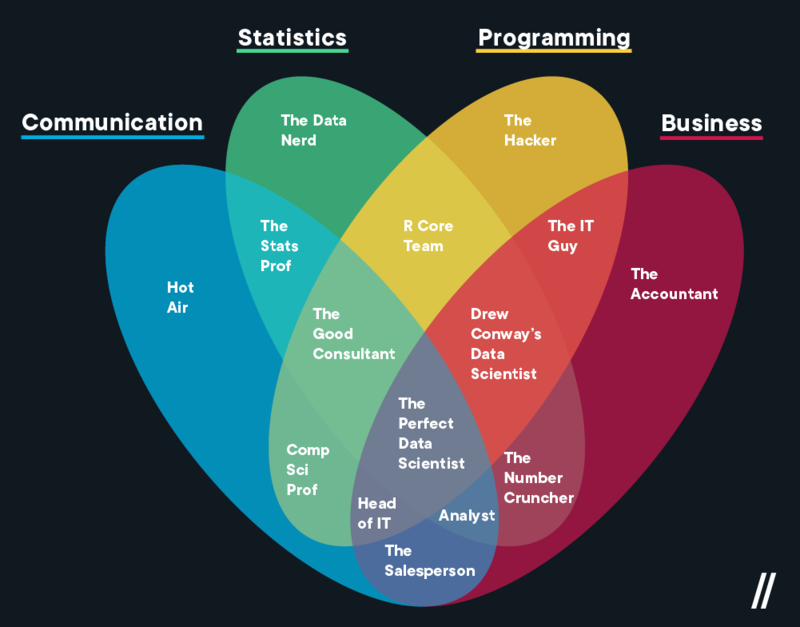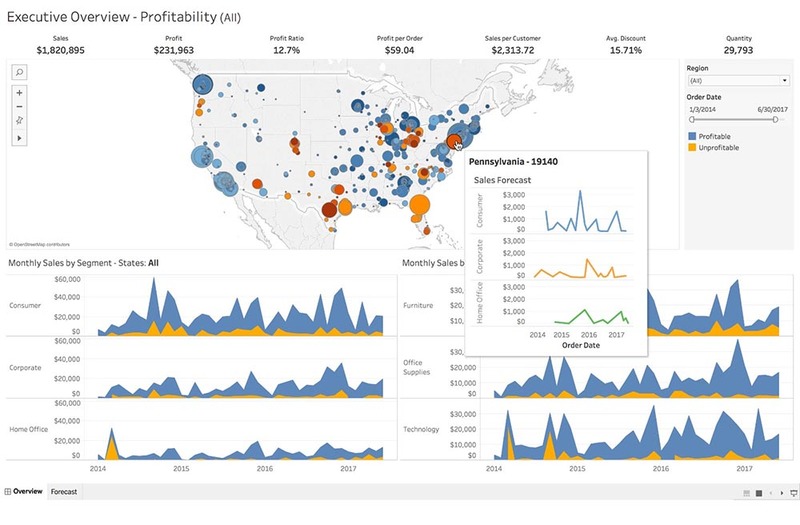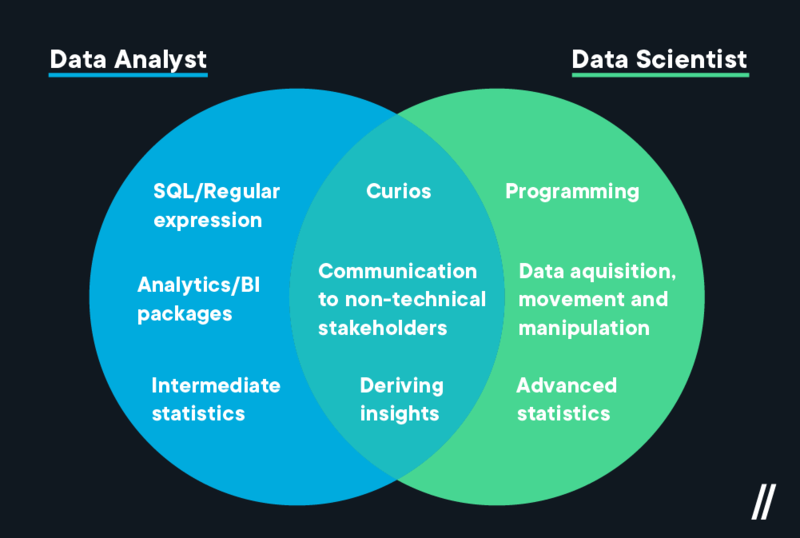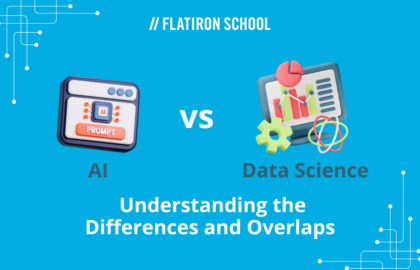If you’re interested in a career in data science, you’re in the right place. The more information you equip yourself with, the easier it will be for you to make the right decision about your future career and the decisions that lead you there.
Learning the ins and outs and everything else about a data science career can seem like a never-ending task.
That’s why we’re here to help guide you through the differences between a data analyst and a data scientist.
Data Scientist vs. Data Analyst: What They Do
As companies deal with more and more data, it’s difficult for them to find practical or scalable ways to deal with it. This leads to key insights being missed and lucrative business opportunities disappearing.
This is why data analysts and data scientists are so important — to help companies identify actionable insights and make data-driven business decisions. Though both data analysts and data scientists offer their expertise for a company’s greater good, their day-to-day routines look a bit different.

What Does A Data Analyst Do?
Data analysts retrieve and gather data and organize that data to reach meaningful conclusions — and do so across all industries.
The insights that data analysts can bring to a company can be invaluable to understanding their customers.
- A data analyst’s primary role is to scan and analyze data. They give explanations, reports, and visualizations to show insights determined from the data. Data analysts use their expertise to help people companywide understand data through visualization.
- A data analyst uses statistical tools to interpret data sets and analyze trends and patterns that are valuable for diagnostic and predictive analysis.
- Becoming a data analyst also means you must be proficient at extracting and processing data using SQL and business intelligence software. You should also be an expert in programs like Excel and Tableau (picture below) to maintain metrics dashboards.

Analysts have been around well before big data, which is why data analyst roles are specific and well understood. They need to be good communicators because they work with different departments and need strong presentation/visualization skills to convey the insights they find. Data analysts don’t always need expert coding skills but usually have experience with analytics software, data visualization, and data management programs.
An analyst is a storyteller and a prophet finding truths in data. For example, you can see the work of a data analyst in the form of a marketing report projecting future sales of a product or the success of an ad campaign.
Some data analysts do use code in their day-to-day duties but it’s typically not required or requires only a basic understanding to help clean and normalize a company’s data. Learning programming languages is usually in a data scientist’s purview, and advanced coding skills aren’t critical to an analyst’s success., but even still, it’s not rare for an analyst to have Python, SQL, or R proficiency.
Further reading: How to become a data analyst.
What Does A Data Scientist Do?
A data scientist is someone who collects, cleans, and explains data. The primary role of a data scientist is to tweak and adjust the statistical and mathematical models applied to acquired data. Perhaps more than anything, data scientists make discoveries while they swim in data.
Data scientists love to use data to navigate the world around them and find solutions. In a competitive landscape where challenges keep changing, and data never take a break from flowing, data scientists are vital to help decision-makers shift from ad hoc analysis to an ongoing conversation with data.
- Data scientists are responsible for translating formal business problems into workable data questions. They also build predictive models to predict upcoming data.
- A good data scientist knows how to theorize, implement, and communicate the acquired data effectively.
- People in data scientist roles know they face technical limitations, but they don’t allow that to stop them on their quest for novel solutions. As they make discoveries or predictions, data scientists communicate what they’re learning and suggest its implications for new business directions.
- Data scientists are creative in displaying their information and discovering ways to make their findings more clear and compelling.
A data scientist interprets data, much like a data analyst, but can code models or algorithms to gain even more insight into that data.
We can use Netflix to highlight the data analyst vs. data scientist difference.
Netflix has hundreds of millions of subscribers watching a range of TV shows and movies. That’s information a data analyst can use to identify viewing habits or consumer trends. An analyst can use the data to identify the most popular shows or movies in each state, country, or by other categories that can be used to determine what gets promoted by Netflix.
Netflix always figures out the right movie or TV show to recommend. Sure, some of that is based on your own viewing habits, but Netflix also divides users into thousands of taste groups through machine learning and algorithms (this is where data scientists come in), according to Wired.
Netflix’s recommendation system uses data mining to find common threads in everything you’ve watched to create individual profiles. Netflix is also tagging everything you watch, which adds another layer of data that is used to create a profile group. That all adds up to a recommendation for “Action Movies Featuring Strong Female Leads” or “Gritty Cop Dramas.”
Netflix’s algorithm may get the glory, but a team of data scientists and data engineers created the recommendation system. Data scientists are rare and have experience with software engineering and software development, coding, statistical analysis, and data visualization.
Data Scientist vs. Data Analyst: Role Requirements
The role requirements for data analysts are as follows:
- Data analysts usually have STEM bachelor’s degrees or have graduated from a data bootcamp. They aren’t, on the other hand, required to have an advanced degree.
- Data analysts are also not required to have advanced coding skills. Instead, they should have experience using analytics software, data visualization software, and data management programs.
- As with most data careers, data analysts must have high-quality mathematics skills. They should also have strong science, programming, and predictive analytics skills.
- Analytical skills and attention to detail are very important for data analysis. Data analysts work with large amounts of data, facts, and figures. That’s why they must be able to collect, organize, analyze, and disseminate significant amounts of information with attention to detail and accuracy.
- Data analysts should have the ability to deal with ambiguity and competing objectives in a fast-paced environment.
- Data analysts must have the ability to apply common concepts and carry out work according to specific instructions and set procedures.
- It’s also important that data analysts are effective communicators with strong analytical and technical skills, reporting acumen, creativity, teamwork, and intellectual curiosity.
The role requirements for a data scientist include:
- Data scientists often have advanced degrees, and are experts in math, statistics, or computer science.
- Data scientists should have experience in data querying languages like SQL, scripting languages like R, Python, or Java, or statistical/mathematical software like Weka, SAS, Hadoop, or Matlab.
- Data scientists should possess depth and breadth in quantitative knowledge and have excellent quantitative modeling, statistical and analytical skills, and problem-solving skills.
- Data scientists’ most essential and universal skill (and the one that sets them the most apart from data analysts) is the ability to write code. As the data scientist interprets data, they can use code to build models or algorithms that will help them gain even more insight into the data.
- Similar to data analysts, but even more true, data scientists must be able to communicate in a language that all of their stakeholders will understand.
- Data scientists should know statistical computer languages including R, Python, and SQL and have at least three years of experience working with them, as well as experience working with and creating data architecture. Another area of expertise required is manipulating data sets and building statistical models.
- Data scientists should have experience processing, filtering, and presenting large quantities (millions-billions of rows) of data.
- Data science and business problems go hand in hand. That’s why data scientists should also possess an intense curiosity that pushes them to scratch much deeper than the surface of a problem and find answers, then distill the answers into a clear set of hypotheses that can be tested.

Data Scientist vs. Data Analyst: How Much Do They Earn?
How much does a data analyst make?
According to Built In, the average salary in the U.S. for a data analyst is $84,393.
How much does a data scientist make?
There is currently a shortage of data scientists that is becoming problematic in some sectors. This shortage, coupled with the advanced education and experience required to become a data scientist, makes them very well paid. According to Built In, the average salary for data scientists is $126,554.
Business Analyst vs. Data Scientist vs. Data Analyst
When we talk about data and data-related careers, there’s a third one that commonly gets grouped in with data scientists and analysts: the business analyst. Let’s go over how a business analyst and data scientists work:
- The data analyst is the gatekeeper over an organization’s data, allowing stakeholders to understand it and use it to make strategic business choices.
- The business analyst is a strategic role that focuses on using information discovered by the data analyst to identify problems and find solutions.
- Finally, the data scientist takes the data visualizations the data analysts create and takes it up a notch by sifting through data to find weaknesses, trends, and opportunities for their organization.
Choosing Between A Data Analytics And A Data Science Career
Data analyst and data scientist careers are both in-demand in a field that continues to grow. In fact, data scientists rank #4 in Best Technology Job, and the global data analytics market is expected to grow from $7.03 billion in 2023 to a staggering $303.4 billion by 2030.
When deciding between a career as a data analyst or a data scientist, there are few things to keep in mind, including:
Personal background
Data science and data analysis have their own unique sets of requirements. If you’re choosing between the two, you should consider your background, education, work experience, and other pertinent factors to see which career aligns best with your skills and future goals. Analysis is typically less senior and requires fewer technical skills than data science, so understand how interested you are in learning to code.
Your interests
If you love numbers, programming, and statistics, you will love being a data analyst. If you’re advanced in math, statistics, or computer science and knowledge of the business world, you may be better aligned with a data scientist career.
Your desired salary and career path
As with any career, salary and career path are essential factors when deciding between a data analyst and data scientist career. Since different levels of experience and education are required for data scientists and data analysts, the levels of compensation are different. Consider that when choosing between the careers.
Keep in mind that even if you decide to start as a data analyst, you can become a data scientist with a few additional programming skills
As you can likely tell by now, both roles have a decent amount of overlap. The key difference between a data analyst and a data scientist is the required coding experience.
For a data analyst to begin earning around $50,000/year, all they must do is learn SQL and Python. Even better, you can learn how to code pretty quickly.
If you are intrigued by becoming a data scientist or data analyst, Flatiron School’s Data Science Bootcamp equips you with the skills to analyze complex data, utilize foundational machine learning modeling, and transform data into solutions that drive decision-making—all in as little as 15 weeks.
Ready to dive into the world of data and start your career in this exciting field? Apply today and take the first step toward shaping the future with data!




